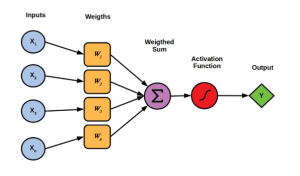Deep learning is one of the most useful and trending topics in the current world scenario, which works on the concepts of neural networks, computer vision, perceptrons, and many other techniques. Perceptrons are algorithms used for supervised learning processes where the input data is taken, processed by neurons, and then the output is represented.
In this article, we will discuss the perceptron, its core intuition, its working mechanism with examples, the advantages of using perceptrons, and some other important stuff related to the same. This will help one to understand the perceptrons conceptually and will have a better idea about the perceptrons and other deep learning terminologies.
Table of Content
- What is Perceptron?
- Types of Perceptron
- Working mechanism of Perceptron
- Advantages of Single-Layer Perceptron
- Advantages of Multi-Layer Perceptron
- Key Takeaways
- Conclusion
What is Perceptron?
In 1957 Percepron was introduced by frank Rosenblatt. He proposed a supervised learning algorithmic structure of the neural networks, which can be used for the classification problem, but due to its simplicity and efficiency, it became the building block of the neural networks.
As we can see above that, there is a complex neural network structure available with the input, hidden, and output layers. This structure is known as the perceptron or perceptron algorithm. Here we can see that the input X is passed to the input layers where the weights and biases will be assigned, and the input will be passed to the next hidden layers. Here the neurons will process the input and will pass the same to the next layers of the neural network. After that, the weighted sum will be applied, and following the activation functions and the output will be displayed.
To achieve better accuracy of the model, optimizers are used, which backpropagate the algorithms and reassign the weights and biases to the algorithms which best fit the model.
Types of Perceprons
Mainly there are two types of perceptron that can be used:
Single-Layer Perceptrons
This perceptron algorithm has only one layer of the neural networks and results in an output according to the weights and biases assigned.
Multi-Layer Perceptron:
In this type of perceptron, there are multiple hidden layers available in the neural networks, where weights and biases are assigned to the layers and neurons of the networks. Here the model results in an Output according to the processing of the hidden and output layers.
It is observed that the single-layer perceptrons are a very good fit for the linear kind of data, which is linearly distributable, and there is no nonlinearity exists.
Multi layers perceptrons are widely used over single-layer perceptrons as the performance of the multi-layers perceptrons is better than single laters perceptrons on complex types of datasets. The multi-layer perceptrons can recognize and solve the data patterns of the non-linear kind o data.
Working Mechnism of the Percepron
After getting a clear idea of the perceptrons, let us now try to understand the working mechanism of the perceptrons with an example.
Let’s suppose that we are working on a classification algorithm where our goal is to predict whether a student will pass or fail according to his/her study hours. So here, the independent column or feature would be the study hours of the student, and the target variable or the dependent variable would be the results of the student, which states whether a student passed or failed.
Now here, the input data will be passed to the input layer of the neural network or perceptron, which will be again passed to the following hidden layer of the neural network architecture; the weights and biases will be assigned to the neurons and hidden layers, and in the end, the output will be displayed after applying activation function.
Now if we think simply, the data can also be separated ion a graph with a straight line if the data is linear, the same mechanism that we apply in logistic regression.
 Image Source: Self Generated
Image Source: Self Generated
As we can see in the above image, on the X axis so the graph, we have the study hours of the student, and on the Y axis, we have plotted the results of the student. A straight line in the graph separated the student who passed or failed the exam. The student above the straight line appears in blue color, which is a student who passed the exam, and the student that is below the straight line appears in black color, which failed the exam.
The working mechanism of the perceptron is very similar to the logistic regression algorithms, which is a classification-supervised machine learning algorithm.
Advantages of Single Layer Perceptrons
1. Efficient on Linear Data
The single layers perceptrons can easily classify the linear data with a straight line.
2. Computational and Time Complexity
Single layers perceptrons are mainly used for linear data, which does not require many parameters to define and train, and that is why the computational and time complexity of the algorithms is very low.
Advantages of Multi-Layer Perceptrons
1. Non-Linear Datasets
The multilayer perceptrons can be used over a nonlinear dataset where the algorithms can recognize and solve the pattern behind the nonlinear data and works efficiently on the same.
2. A large amount of Data
The multi-layer perceptrons can handle large amounts of data compared to the single layers perceptrons.
3. Prediction Time
The multi-layer perceptrons require a large amount of time to train in the complex and huge amount of data, but once trained the model can provide very quick results or outputs for the query points or datasets.
Key takeaways
- Perceptrons were introduced by Frank Rosenblatt in 1957.
- Perceptrons are structures or algorithms in the neural networks with input, hidden, and output layers which can be considered a classification supervised learning algorithm.
- The perceptron became the building block of these neural networks due to its easy to applicable structure and efficient results.
- Linear regression is also referred sometimes as perceptron algorithms; the working mechanism of both algorithms is the same.
- Single layers perceptrons perform very well on linear data, and multi-layer perceptrons can be used over nonlinear data.
- The multi-layer perceptrons can provide quicker predictions once it is fully trained.
Conclusion
In this article, we discussed the perceptrons, their core intuition, their working mechanism, and the advantage of the single-layer and multi-layer perceptrons with examples., This article will help one to understand the concept of perceptrons very clearly and will clear the fundamental concepts to learn and apply deep learning techniques further.


